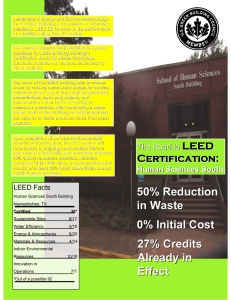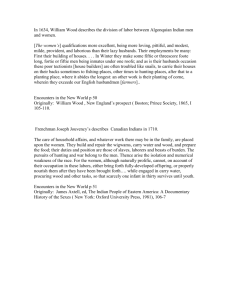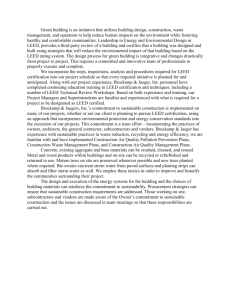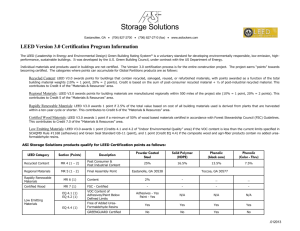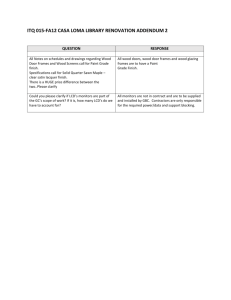Green Building Certification’s Role in Meeting USDA Strategic Objectives
advertisement
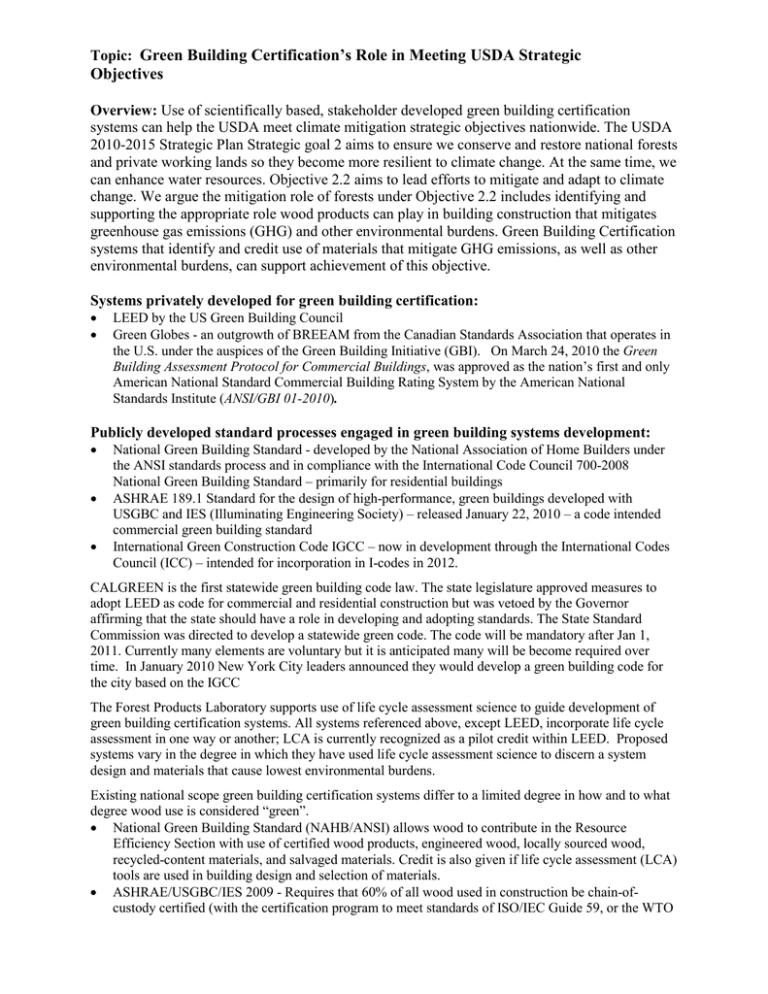
Topic: Green Building Certification’s Role in Meeting USDA Strategic Objectives Overview: Use of scientifically based, stakeholder developed green building certification systems can help the USDA meet climate mitigation strategic objectives nationwide. The USDA 2010-2015 Strategic Plan Strategic goal 2 aims to ensure we conserve and restore national forests and private working lands so they become more resilient to climate change. At the same time, we can enhance water resources. Objective 2.2 aims to lead efforts to mitigate and adapt to climate change. We argue the mitigation role of forests under Objective 2.2 includes identifying and supporting the appropriate role wood products can play in building construction that mitigates greenhouse gas emissions (GHG) and other environmental burdens. Green Building Certification systems that identify and credit use of materials that mitigate GHG emissions, as well as other environmental burdens, can support achievement of this objective. Systems privately developed for green building certification: • • LEED by the US Green Building Council Green Globes - an outgrowth of BREEAM from the Canadian Standards Association that operates in the U.S. under the auspices of the Green Building Initiative (GBI). On March 24, 2010 the Green Building Assessment Protocol for Commercial Buildings, was approved as the nation’s first and only American National Standard Commercial Building Rating System by the American National Standards Institute (ANSI/GBI 01-2010). Publicly developed standard processes engaged in green building systems development: • • • National Green Building Standard - developed by the National Association of Home Builders under the ANSI standards process and in compliance with the International Code Council 700-2008 National Green Building Standard – primarily for residential buildings ASHRAE 189.1 Standard for the design of high-performance, green buildings developed with USGBC and IES (Illuminating Engineering Society) – released January 22, 2010 – a code intended commercial green building standard International Green Construction Code IGCC – now in development through the International Codes Council (ICC) – intended for incorporation in I-codes in 2012. CALGREEN is the first statewide green building code law. The state legislature approved measures to adopt LEED as code for commercial and residential construction but was vetoed by the Governor affirming that the state should have a role in developing and adopting standards. The State Standard Commission was directed to develop a statewide green code. The code will be mandatory after Jan 1, 2011. Currently many elements are voluntary but it is anticipated many will be become required over time. In January 2010 New York City leaders announced they would develop a green building code for the city based on the IGCC The Forest Products Laboratory supports use of life cycle assessment science to guide development of green building certification systems. All systems referenced above, except LEED, incorporate life cycle assessment in one way or another; LCA is currently recognized as a pilot credit within LEED. Proposed systems vary in the degree in which they have used life cycle assessment science to discern a system design and materials that cause lowest environmental burdens. Existing national scope green building certification systems differ to a limited degree in how and to what degree wood use is considered “green”. • National Green Building Standard (NAHB/ANSI) allows wood to contribute in the Resource Efficiency Section with use of certified wood products, engineered wood, locally sourced wood, recycled-content materials, and salvaged materials. Credit is also given if life cycle assessment (LCA) tools are used in building design and selection of materials. • ASHRAE/USGBC/IES 2009 - Requires that 60% of all wood used in construction be chain-ofcustody certified (with the certification program to meet standards of ISO/IEC Guide 59, or the WTO • • Technical Barriers to Trade document). Support is given for use of recycled-content materials, salvage and reuse, and locally sourced materials. There is a requirement that life cycle assessments be performed for a minimum of two alternative building designs. IGCC draft standard - As in the National Green Building Standard, the draft standard is comprehensive and includes language supporting use of certified wood, and use of life cycle assessment in building design and selection of construction materials. LEED – currently provides credits for use of FSC certified wood and locally sourced wood. LEED is piloting an approach to incorporating LCA into all its standards, although adoption of the pilot credit is viewed by many observers as unlikely. Were the pilot to be adopted as currently written structural/envelope assemblies would be evaluated using an LCA impact calculator and up to 7 credits would potentially be awarded based on the magnitude of impact of the selected assemblies vs. the average and lowest impact options. Recent green building initiatives indicate a clear trend toward green in building construction that includes demand for recycled-content, re-used/refurbished products, regionally-sourced materials, and certified wood. In addition, with language regarding life cycle assessment now in all of the new national scope standards, as well as the new California code and the Green Globes standard, and likely soon in the USGBC LEED program, there is every indication that use of LCA represents a new way of doing business in the future. Estimates of Wood Use in Certified Building Employing the most widely used LEED system, most certification takes place in new non residential buildings. An estimated 2.4 billion square feet of low-rise residential buildings (4 stories or less) were constructed in 2009, said the US Department of Commerce and McGraw Hill. Some experts say up to 25% of non residential building starts are registered with LEED. Today half of the starts follow through to full certification. 1 If we use these fractions and wood use rates per square foot of low rise buildings; and if an estimated 294 million square feet follow through will certification, then associated wood use could total about 390 million board feet. These estimates, however, represent order of magnitude and require further confirmation. Wood is also used in other residential and commercial buildings that are green certified by LEED or other systems so total wood use will be larger. Even if the amount is off by a factor of 2 or more, it is likely to be a small fraction of the estimated 57 billion board feet softwood and hardwood lumber consumed in the U.S. in 2009. Ways to Expand Wood Use in Green Building • • • 1 Enhance support systems that use life cycle assessment to chose building designs and materials that reduce environmental burdens Support systems that use broad stakeholder participation and decision making in their development and modification Support systems, when they require environmental certification of building materials, to require similar certification protocols for all building materials, not just wood materials. From “Green building market and impact report 2009” by R. Watson, GreenerBuildings.com. http://www.greenbiz.com/sites/default/files/GreenBuildlingImpactReport2009.pdf
